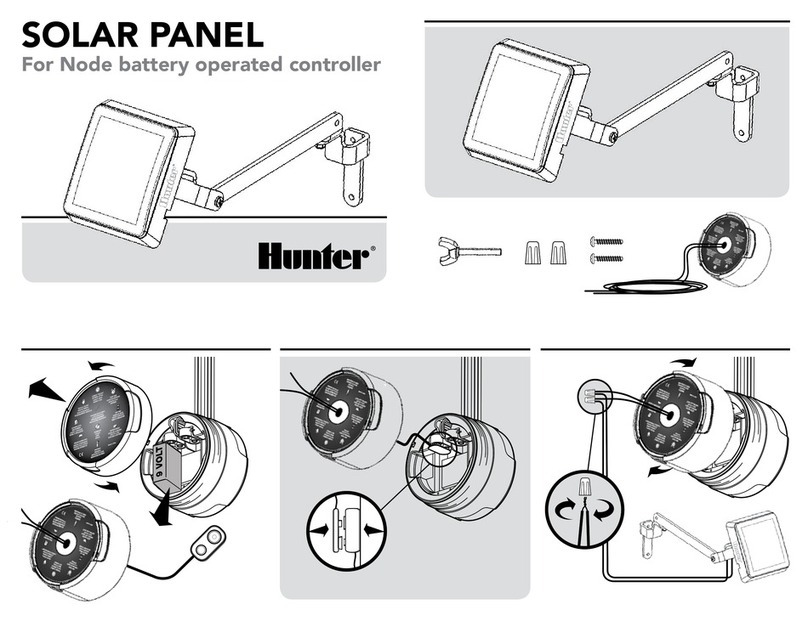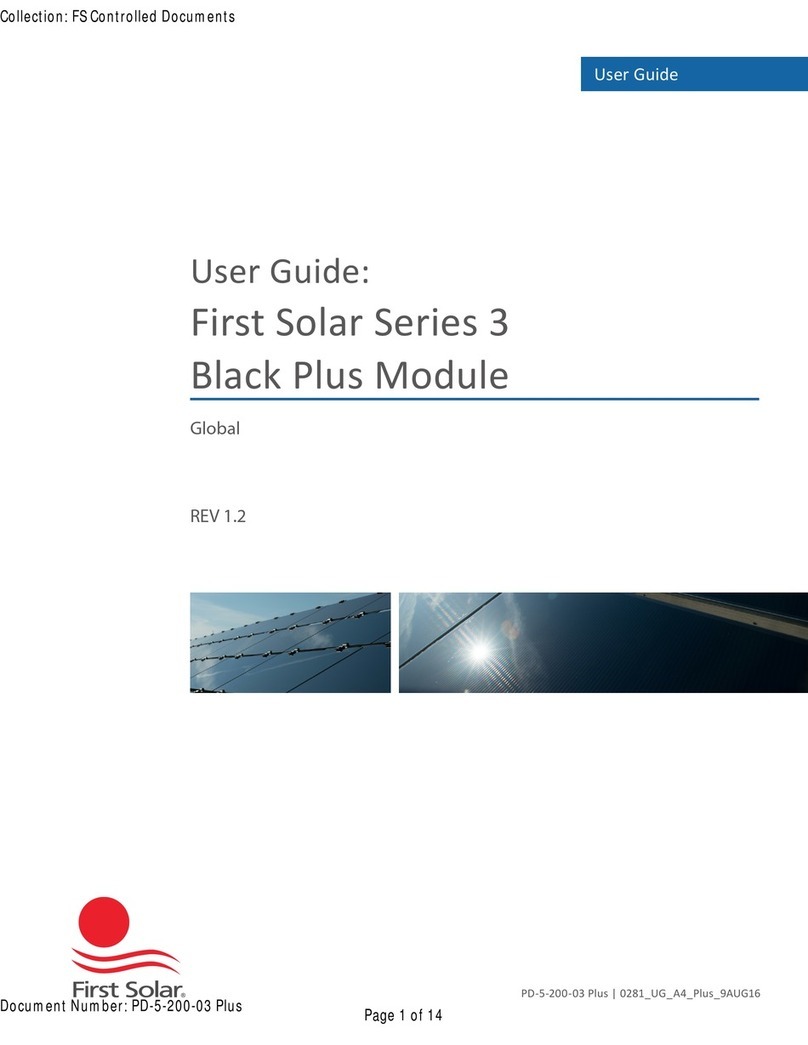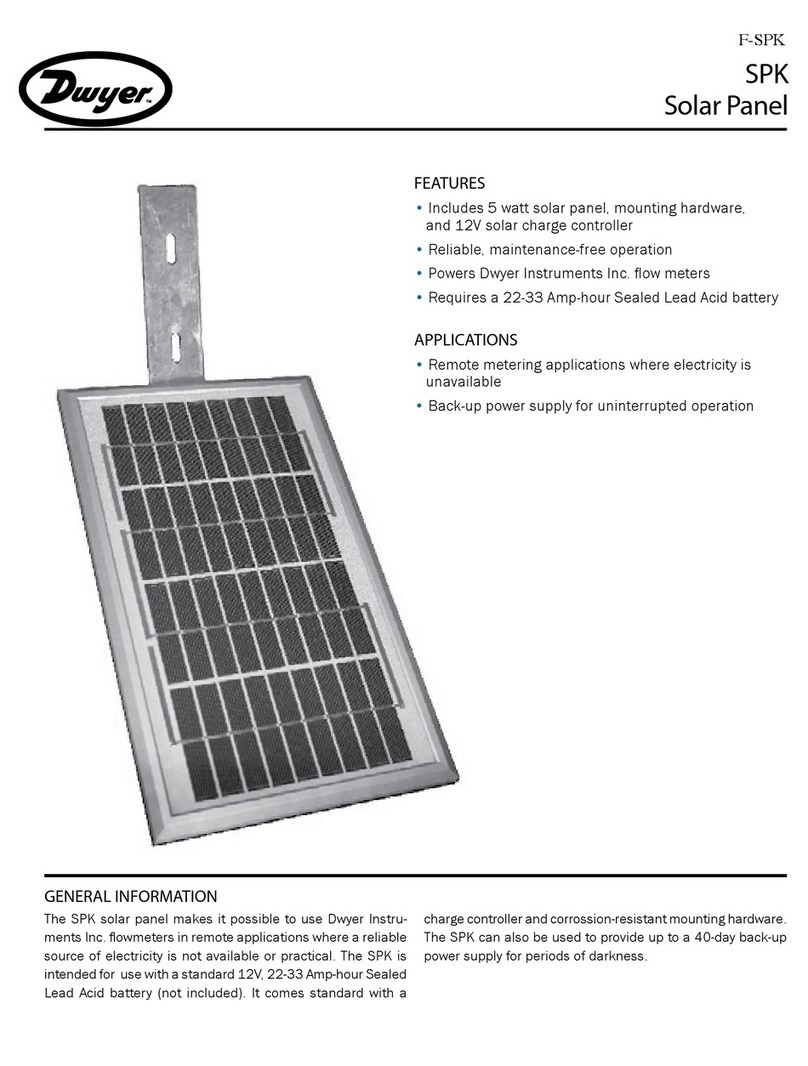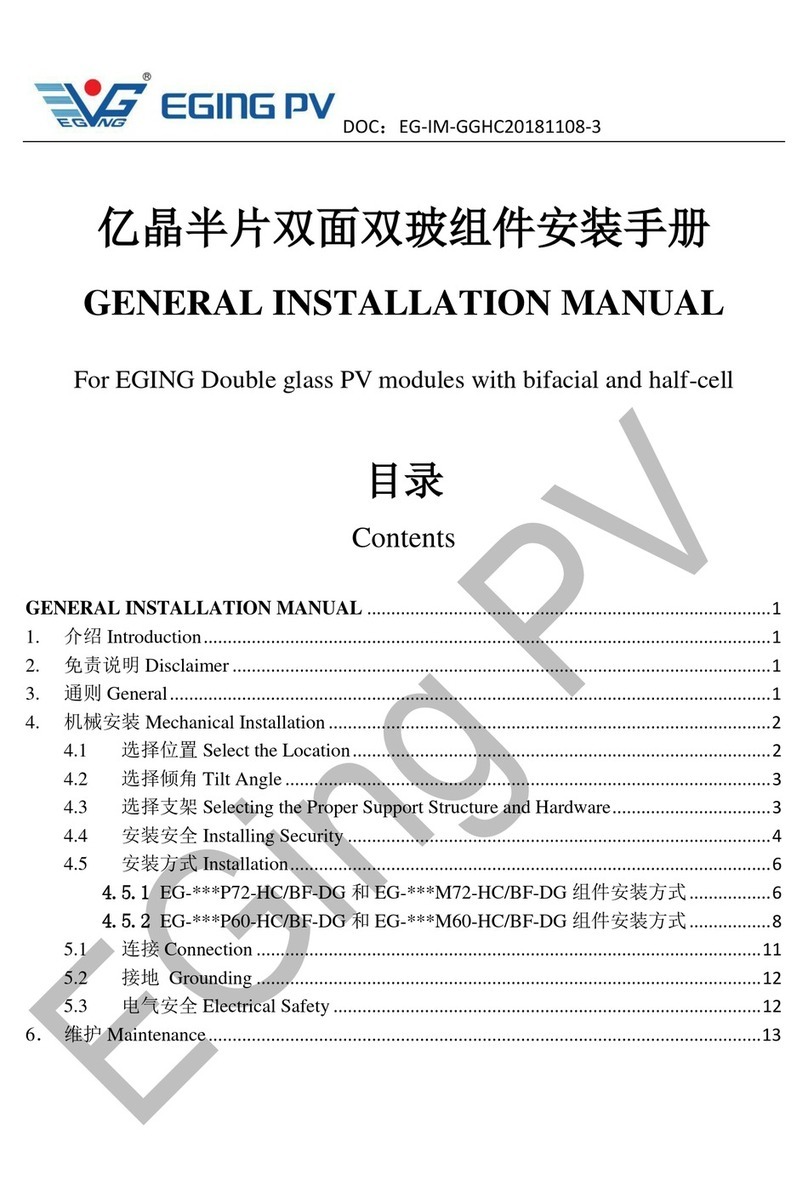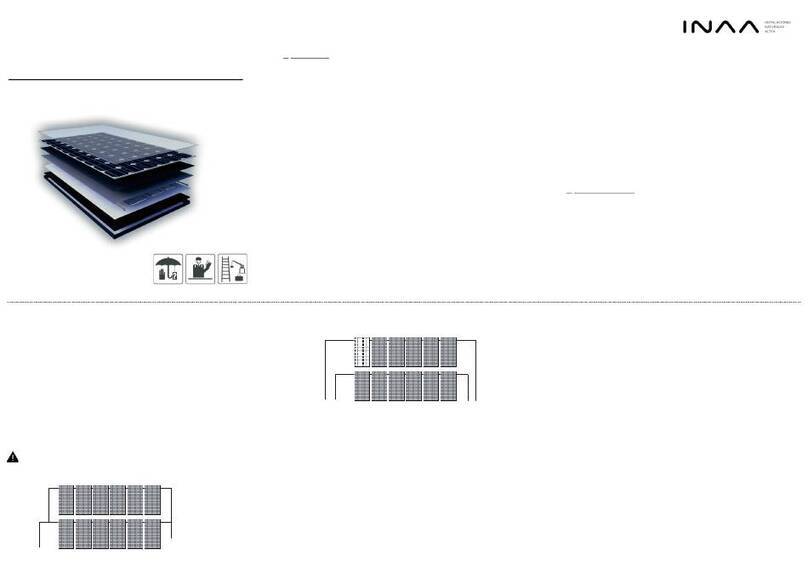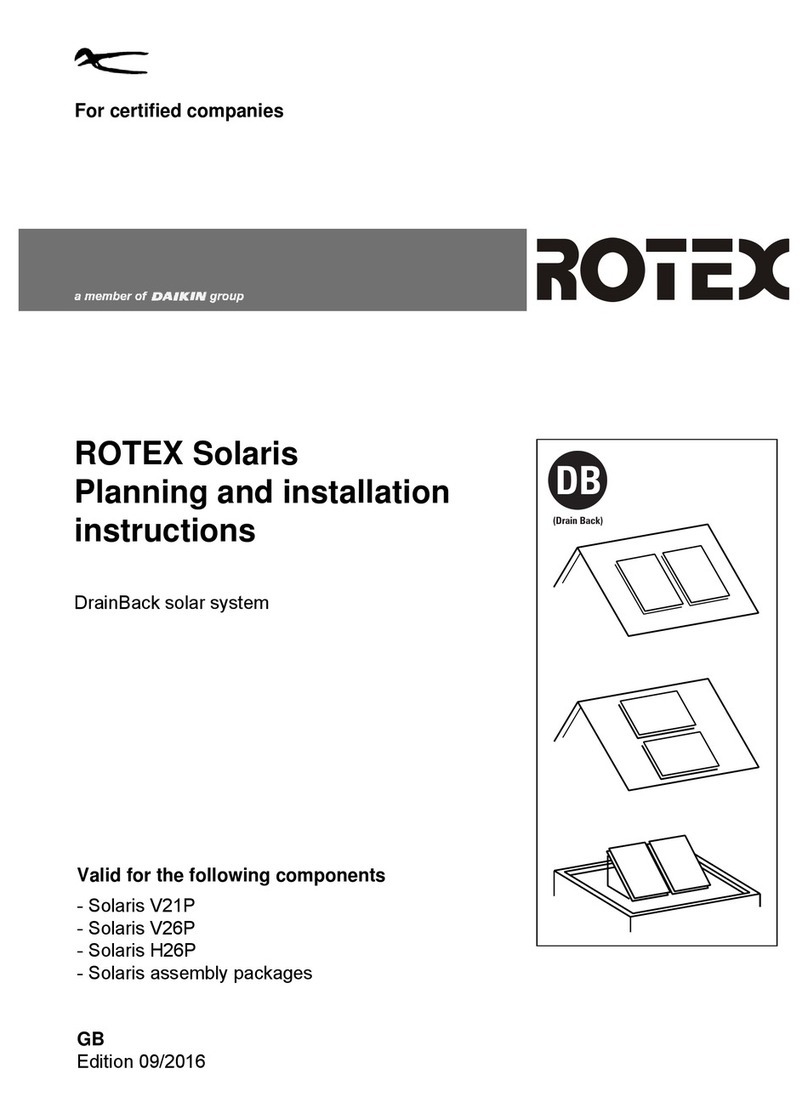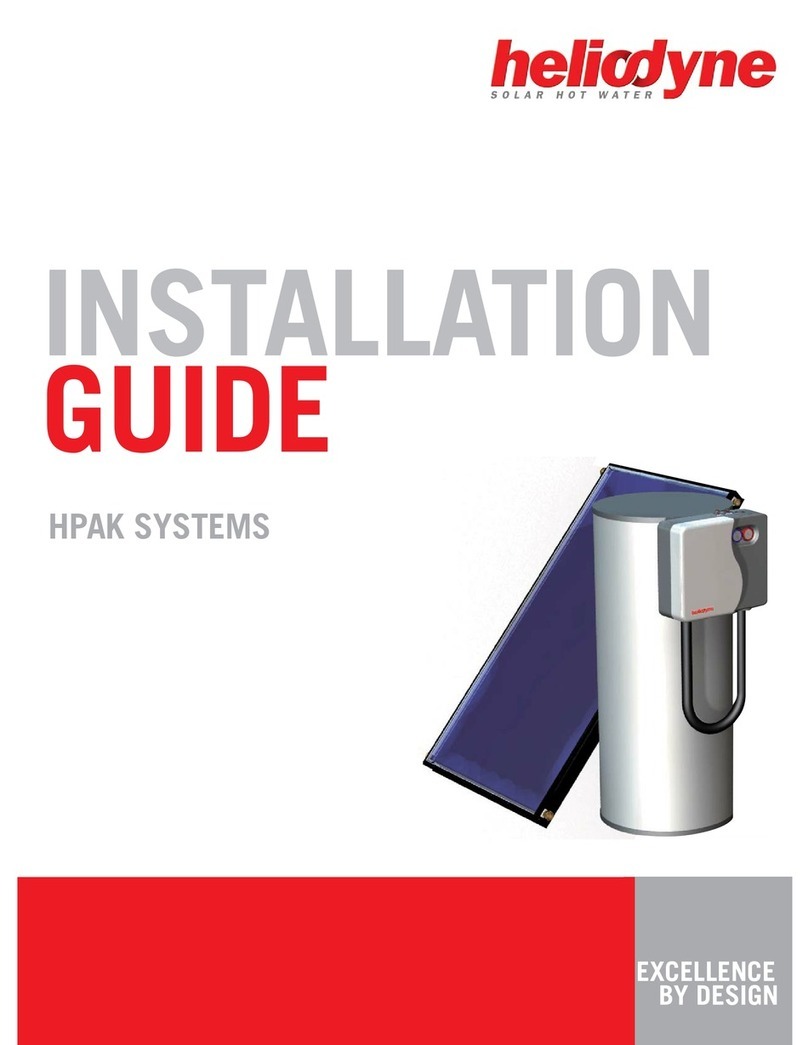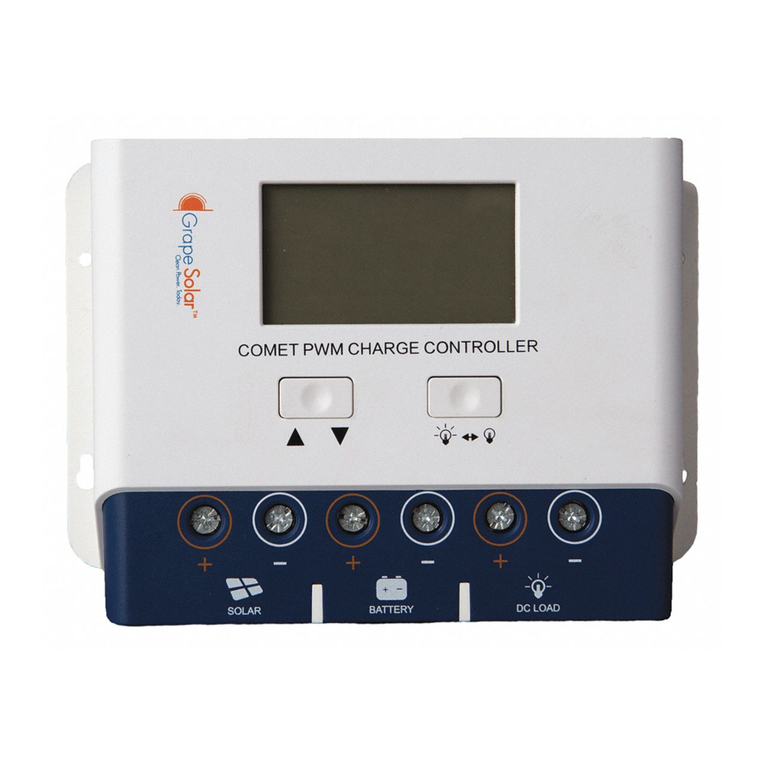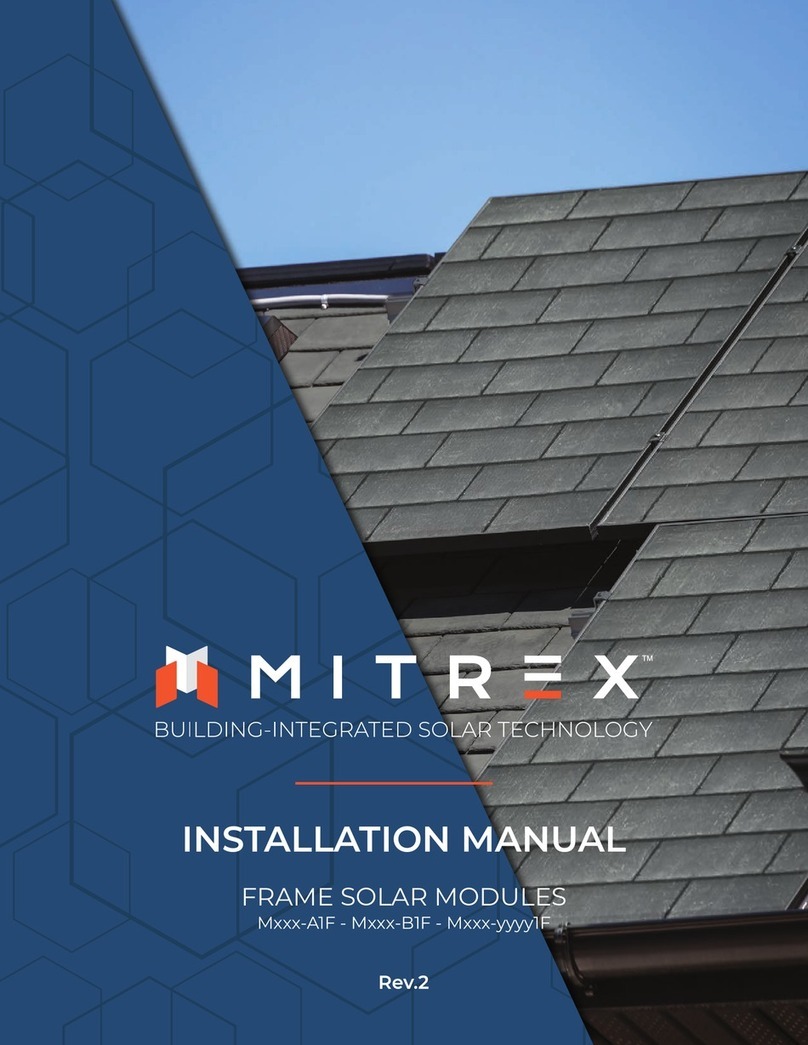Mounting Systems Pitched ProLine User manual

Pitched ProLine
Installation manual

Pitched ProLine-MA-EN-2011
Introduction
Introduction
. Short Description
. About These Instructions
. Warnings
. Safety
Technical Description
. System Overview
. Components
. Technical Data
Important Mounting Information
. Conditions of Use
. Mounting Preparations
. Mounting Aids and Required Tools
. About the Instructions
Planning the Module Area
Installation of Roof Fasteners
. Preparation of the Roof Substructure
. Placing the Roof Fasteners –
Here: Standard Roof Hooks
. Placing the Roof Tiles
Installing the Base Rails
. Placing and Alignment of the Base Rails
. Connection of the Base Rails
. Placing the End Caps
. Telescoping End Pieces (optional)
Installing the Clickstones
Module Installation
. Fastening the Modules on the Outer Side
. Fastening the Modules on the Inner Side
. Fastening Additional Module Rows
Options: Installing Additional Roof Fastener
. Installation of the Heavy Load Roof Hooks
. Installing Adjustable Roof Hooks
. Installation of Plain Tile and Slate Roof Hooks
. Installing Hanger bolts
. Roof connection with hanger bolt
. Installing Standing Seam Clamps
Option: Installation of the CCS-rail
. Placing and Alignment of the CCS-rail
. Connection of the CCS-rail
Option: Cross Rail Installation

3
Installation manual Pitched ProLine
i
1. Introduction
.. Short Description
The Pitched ProLine on-roof system is a robust
mounting system for the installation of PV modules on
pitched roofs.
It consists of aluminium support rails and all necessary
small parts for the fastening of the rails to the roof, the
modules on to the rails as well as for the connection
of the components with each other. Pitched ProLine
allows for both portrait and landscape installation of
the modules.
.. About These Instructions
Content
These instructions describe the mounting of the on-
roof system Pitched ProLine and all system-specific
information for planning, components and safety
warnings.
The first part of the Instructions (chapters –)
demonstrates the complete installation of framed
modules. Thereafter, (chapters –) the mounting
steps for certain specific roof types and material
options are explained.
Applicable Documents
In addition to this document, the document
“Installation Instructions for PV Mounting Systems:
General Part” is part of each product delivery.
This document describes the general applicable
information for Mounting Systems products on
standardisation, safety, transport, maintenance,
disassembly and disposal. Both the present Instructions
and the “Installation Instructions for PV Mounting
Systems: General Part” are an integral part of the
system Pitched ProLine and must be adhered to for
each installation.
It is crucial to carefully read these Instructions as well
as all applicable documents prior to carrying out any
installation, maintenance or disassembly work. You are
provided with the information required for the safe and
complete installation, maintenance and disassembly.
Should you have any questions, please contact
Mounting Systems GmbH.
User Group
Mounting Systems GmbH’s installation instructions are
intended for the following persons (user group):
• Skilled personnel
• Instructed personnel
Skilled personnel
Skilled personnel are individuals who, on the basis
of their professional training, are able to execute
installation, maintenance, and disassembly work
appropriately.
Instructed personnel
Instructed personnel are individuals who have been
instructed and taught appropriately regarding the
assigned tasks and the possible risks in the event of
improper conduct. An instructed individual must have
received instructions regarding the required safety
policies, precautions, relevant regulations, accident
prevention regulations, as well as operating conditions
and must have demonstrated his/her competence.
The implemented work must be approved by skilled
personnel.
Orientation Guide
The following visual aids will make installation easier.
Piktograms:
This symbol indicates important information
and useful tips.
This symbol indicates tips and tricks to make
processes easier.

Installation manual Pitched ProLine
1.3. Warnings
The warnings used in these Mounting Instructions
indicate safety-related information. They include:
• Warning symbols (pictograms)
• Signal words for the identification of the hazard level
• Information about the type and source of the hazard
• Information about potential consequences in case of
the hazard being disregarded
• Measures for the prevention of hazards and the
prevention of injuries or damage to property.
The signal words of the warnings respectively indicate
one of the following hazard levels:
1.4 Safety
All generally applicable safety regulations for products
of Mounting System GmbH can be viewed in the
document “Installation Instructions for PV mounting
Systems: General Part”. Please read this document
carefully and adhere to the described points - only use
the system for its intended purpose, comply with the
obligations of the building proprietor and follow both
the general and specific safety instructions.
In addition, please observe the specific safety
instructions which precede the process steps in the
present product-specific Mounting Instructions.
Indicates a great and extraordinary
danger, which may result in death
or serious injury if ignored.
Indicates a potentially dangerous
situation, which may result in
serious or medium injury or
damage to the property.
Indicates a potentially dangerous
situation, which may result in
minor injuries or damage to the
property if ignored.
Indicates potential danger,
which can result in damage
to the property.
WARNING
CAUTION
ATTENTION
DANGER

5
Installation manual Pitched ProLine
2. Technical Description
2.1 System Overview
In the following, the most important system parts are
described.
The design of the individual system components can vary,
or additional components may be required, depending on:
• Type of roof (substructure and roof cladding)
• Type of module
• Number of modules and configuration
• Local conditions
Image 2.1-1 Portrait Installation
Pitched ProLine Components:
a Roof hook
b Base rail
c Connector
d Telescoping end piece (optional)
e Module clamp
f Module end clamp
f
a
b
e
c d

Installation manual Pitched ProLine
2.2 Components
In the following all mounting system parts of the Pitched ProLine are shown, which can be included in the scope of the
delivery. The exact scope of the delivery and the number of individual components depends on your order.
2.2-1 Base rail (BR), options:
• BR 4/35 in various lengths
• BR 6/40 in various lengths
• BR 10/48 in various lengths
• 0.6 m pieces in black
(respectively for BR 4/35 and BR 6/40)
• BR 4/35 CCS
2.2-2 Connector, options:
• Internal connectors (respectively for BR)
• External connectors (respectively for BR)
• Connector CCS
2.2-3 Telescoping end-piece (optional), options:
• For BR 4/35 and BR 6/40
• Either with mill finished or black end piece
2.2-4 Module end clamp, options:
• For dierent module frame heights
• Mill finished or black
2.2-5 Module clamp, options:
• For dierent spans of module frame heights
• Mill finished or black
2.2-6 Roof fastener, options:
• Roof hooks in various designs
(example shown here: standard roof hook)
• Hanger bolts in various designs
(example shown here: hanger bolt with rubber seal)
• Sheet-metal clamps in various designs
(example shown here: Kalzip clamp)
2.2-7 Fastening materials for roof hooks in various
designs depending on type of roof hook
2.2-8
Small parts for connecting the roof fastener to the
base rail, options:
• L-bracket + small parts (required for some roof
hooks, hanger bolts and sheet-metal clamps)
• T-head bolt and serrated lock nut (supplied loose)
2.2-9 Cross rail connector
2.2-10 End caps (optional), options:
• For BR 4/35, BR 6/40 and BR 10/48
• Grey or black
2.2-1
2.2-2
2.2-3
2.2-9 2.2-10
2.2-4 2.2-5
2.2-6
2.2-7
2.2-8

7
Installation manual Pitched ProLine
2.3 Technical Data
Application Pitched roof – on-roof
Roof cladding Suitable for most types of roof cladding
Roof slope Up to 60° 1
Building height Up to 20 m 1
PV modules Framed, unframed
Module orientation Portrait, Landscape
Size of module array Any size possible 2
Position of the module array No special requirements
Distance between roof
fixing points
Up to 2m 1
Standards Eurocode 1 – Actions on structures
Eurocode 9 – Design of aluminium structures
Supporting profiles Extruded Aluminium (EN AW 6063 T66)
Hooks, small parts Stainless steel (V2A)
Colour Aluminium: plate finish; on request:
Visible components available in black
Warranty 10 Years 3
1
Dierent maximum values may apply, depending on site, building, choice of roof fixations and module type.
Using the Pitched ProLine calculation tool, you can have the exact values for your specific project calculated quickly and easily.
2 Due to thermal expansion of the material, we recommend an interruption of the array after 12 m.
3 Please find the exact terms in the Mounting Systems GmbH warranty document.

Installation manual Pitched ProLine
3. Important Installation Information
. Conditions of Use
The Pitched ProLine on-roof system is designed
with dierent rail and on-roof fastener variations in
accordance with Eurocode -DIN EN -- for various
maximum loads. The suitability of the material must
therefore be verified for each system, e.g. by means of the
Pitched ProLine configuration tool. Please also observe
the constraints, listed in chapter . “Technical Data”.
. Mounting Preparations
Mounting Systems GmbH recommends you inquire about
the local conditions before ordering the Pitched ProLine.
In particular, acquaint yourself with:
• The roof structure,
• Dimensions, material, quality and distance of the
rafter purlins
• the rafter purlins distance with any irregularities
• Type, quality and fastening method of the roof tiles/
roofing
. Mounting Aids and Required Tools
For the installation of the mounting system, you will
require the following tools:
• Allen key/hexagon socket drill bit, mm and mm
• Socket key/socket key attachment size and size
• Cordless screwdriver/electric drill with attachment for
fastening the wood screws; varying depending on the
roof hooks selected:
• Cross recess (for chipboard screws)
AW (for x wood screws)
• Socket key attachment size
(for x wood screws)
• Socket key attachment size
(for Mx hanger bolts)
• Socket key attachment size
(for Mx hanger bolts)
• Angle grinder with
- Metal cutting disc
- Stone disc
• Chalk Line
• Spirit level
• Yard stick/tape measure
. About the Installation Instructions
In the following chapters all steps for the planning
and mounting of the Pitched ProLine are listed in the
correct sequence. Chapters , , and describe the
mounting steps of the modules, chapters – describe
the mounting steps for other material and installation
variations.
Please adhere to the mounting steps listed and be
ensure to follow the safety instructions.
Risk of fatal injury from
damage to roof
Excessive loads can severely
damage the roof.
• Before mounting and installation,
please make sure that the building
and especially the roof cladding
meets the increased structural
requirements for the PV system
and the mounting operation.
Risk of fatal injury from
falling objects
Parts falling from the roof can result
in serious injuries or death.
• Before commencing with the
installation, please ensure that
the material used meets the
structural requirements of the site.
DANGER
DANGER

9
Installation manual Pitched ProLine
4. Planning the Module Area
For installation, the base rails are fastened to the
rafters or purlins (for metal roofs) of the building with
roof fasteners (e.g. roof hooks). The roof fasteners must
be mounted at defined distances, depending on the
distance of the rafters/purlins, the position on the roof
and on the on-site conditions*. The layout is defined
using a configuration tool or project-related structural
analyses.
* Layout required according to local conditions in
accordance with Eurocode -DIN EN --/
Eurocode -DIN EN --.
Risk of fatal injury from
damage to roof
Excessive loads can severely
damage the roof.
• Before mounting and installation,
please make sure that the
building and especially the roof
construction meets the increased
structural requirements resulting
from the PV system and the
assembly operation.
Risk of fatal injury from
falling objects
Parts falling from the roof can result
in serious injuries or death.
• Before any mounting or
installation, please make sure
that the material used is suitable
for the building structure and
meets the structural requirements
applicable on-site.
DANGER
DANGER
Image – Modul Area
aHeight of the module field: Number of modules
vertically x module length (+ any clearances)
bWidth of the module field: Number of modules
horizontally x (module width + mm) + mm
cDistance of the base rails vertically (taking into
account the tile pattern as well as the number and
positioning of module clamping points approved
by the manufacturer): Approx. quarter points of the
modules = / x module length.
dDistance of the roof hooks horizontally: According to
the project layout, depending on the rafter distance
and the structural calculations*
eDistance between the modules = – mm
* Layout required according to local conditions in
accordance with Eurocode -DIN EN --/
Eurocode -DIN EN --.
e
a
c
d
b

Installation manual Pitched ProLine
Risk of fatal injury due to falling
Falling from the roof can result in
serious injuries or death.
• Please wear the statutory
protective equipment.
• Secure yourself against falling.
• Do not perform any work in strong
winds.
Risk of fatal injury from
falling objects
Parts falling from the roof can result
in serious injuries or death.
• Block off the hazard area on the
ground prior to the mounting work
to prevent falling objects injuring
persons.
• Ensure that no parts can fall off
the roof.
• Please wear the statutory
protective equipment.
• Do not stay in the hazard area.
• Do not perform any work in strong
winds.
• After completion of the
installation, check the racking
system and the modules for a
tight fit.
DANGER
DANGER

11
Installation manual Pitched ProLine
Damage to the building and the PV
system due to incorrect mounting
Incorrect distance between the roof
fasteners can cause damage to the
building and the PV system.
• Select the distance of the roof
fasteners according to the tool
layout and adhere to it.
• Adhere to the potentially different
distance values defined for roof
fasteners to be placed in the
middle of the roof or along the
edge / in the corners of the roof.
CAUTION
5. Installation of Roof Fasteners
The roof fasteners are fixed to the roof structure and
serve as a connector to the base rails. The permissible
distance between the roof fasteners depends on the
structural requirements and must be laid out specifically
for the project, e.g. with the Pitched ProLine configuration
tool. The type of roof fastener must be selected
according to the respective structural load, substructure
and roof cladding. Depending on the roof construction
and the type of roof fastener, the installation process or
the preparation of the substructure can vary or require
additional structural measures. If you have any doubts,
please contact a specialist roofer.
In the following, the installation of a standard roof hook
is described. The mounting steps for other types of roof
fasteners are described in chapter .
.. Preparation of the Roof Substructure
Mounting steps
• Determine the position of the base rails and the
roof fasteners on the roof, taking into account the
system planning, the tile and rafter pattern and the
permissible clamping points of the PV modules used.
• Push up or remove the roof tiles at the appropriate
points.
Image .-
Image .-
xxx
xxx
xxx
xxx

Installation manual Pitched ProLine
Image .-
Image .-
Image .-
Image .-
Image .-
• Prepare the fastening points of the substructure
for professional mounting of the roof fasteners and
ensure suciently load-bearing, wide and level
contact surface.
i
NOTE!
Depending on the roof structure, type of
roof fastener and structural requirements,
various additional structural measures
might be required at the fastening
points. For example, in a counter-batten
construction, the contact surface might
need to be expanded by additional
squared timber screwed to the rafters.
With a frame structure, the roof trusses
might need to be doubled up at the
appropriate positions.
Damage to the building and the PV
system due to incorrect mounting
Incorrectly installed roof hooks can
break away.
• Fasten each roof hook to the
substructure with the stipulated
number of screws.
• Adhere to the permissible
edge distances distance when
positioning the screws.
If necessary, structurally widen the
substructure.
CAUTION

13
Installation manual Pitched ProLine
Image .-
Image .-
Image .-
Image .-
.. Placing the Roof Fasteners - Here: Standard Roof Hook
Mounting steps
• Position the roof hook and, if required, underlay it;
neither the vertical nor the horizontal stay of the roof
hook may touch the underlying roof tile.
• Align the roof hook.
• Fasten the roof hook with wood screws x to the
rafter. Observe the permissible edge distance for
wood drilling.
Image .-

Installation manual Pitched ProLine
Image .-
Image .-
Image .-
.. Placing the Roof Tiles
Mounting steps
• Correctly process the underside of the removed
roof tiles to ensure that the roof tile can be
replaced cleanly and does not stand up due to the
underlying roof hook.
• Reinstall the roof tiles.
• If required, take additional structural measures to
restore rain proofing.
CAUTION
Damage to building from leaking
Incorrectly installed roof hooks and
incorrectly performed restoration of
the rain proofing of the roof cladding
can result in leakages.
• Prior to installation, make sure
to choose a roof fastener variant
that is suitable for the roof and its
requirements.
• Do not install unsuitable roof
fasteners.
• When mounting the roof fastener
adhere precisely to the mounting
instructions.
• Make sure to perform cut-outs
on the tile or any additional
structural measures that might be
required in a professional manner.
If you have any doubts please
contact a specialist roofing
company.

15
Installation manual Pitched ProLine
6. Installing the Base Rails
The base rails serve as module support and are
available in dierent strengths and lengths.
.. Placing and Alignment of the Base Rails
Mounting steps
• Pre-mount the T-head bolt and serrated lock nut to
the roof hook (nut must point in the direction of the
eaves, T-head bolt in the direction of the ridge)
• Lay out the total rail length per rail track (see
chapter ) and perform any rail cut-outs that might
be necessary.
• Distribute the base rails on the roof.
i
NOTE!
The permitted cantilever (overhanging
of the loose rail ends over the last
roof fastener) is limited to 30 cm.
Do not exceed this limit.
NOTE!
Do not fasten all the base rails at
once, but alternate between
installation steps 6.1. and 6.2.
Install the individual base rails
plugged together with a connector.
Image .-
Image .- Image .-

Installation manual Pitched ProLine
Image .-
Image .-
Image .-
Image .-
• Hold the rail against the roof hook, insert the T-head
bolt in the side channel, loosely fasten the screw with
a quarter-turn in the side channel of the base rail,
and loosely tighten the nut.
• Align the base rails by using a chalk line or spirit level.
• Tighten the lock nuts - torque: Nm. Make sure
the T-head bolts are positioned correctly in the rail
channel.
CAUTION
Material damage due to
incorrect mounting
Incorrectly mounted T-head bolts
can slip out.
• When inserting the T-head bolts,
always ensure the correct, vertical
fit of the bolt head in the channel.
• When aligning the rails and during
the final fastening of the T-head
bolts, make sure that the head
of the bolt does not slip into an
incorrect position.
• Adhere to the specified torque of
20 Nm.

17
Installation manual Pitched ProLine
.. Connection of the Base Rails
Rail connectors are provided for the linking of the
individual base rails. There are two dierent versions of
connectors available for each rail thickness; an interior
connector and an exterior connector.
Mounting steps - interior connector
• Insert the rail connector into the first base rail until the
stop.
• Slide the next base rail onto the placed rail connector
until the stop.
Mounting steps - exterior connector
• Slide the connector halfway into the side channel on
the back of the base rail.
• Push the second base rail to the stop on the
connector.
• Tighten both bolts manually, thus completing the
connection. (torque Nm).
Image .. –
Image .. –
Image .. –
Image .. –
Image .. –
Image .. –
i
NOTE!
Connected rails should not exceed a
length of 12 m. Thereafter, an expansion
joint (approx. 5 cm) must be considered.
Do not install modules over expansion
joints. The total rail length required
depends on the width of the module field.
NOTE!
For this connection type, the base rails
can be pre-assembled on the ground.
This may facilitate transport onto and
placing on the roof.

Installation manual Pitched ProLine
Image .. –
Image .. –
.. Placing the End Caps
The end caps are optional components and only have
an optical function.
Mounting steps
• From the outside, push the end caps onto the ends
of the base rails.

19
Installation manual Pitched ProLine
Mounting steps
• Do not finish the base rail row with a pre-cut base
rail but with the telescoping end piece.
• Slide the telescoping end piece into the side
channel on the back of the base rail.
Image .-
aConnector piece for variable insertion into the base
rail
bBolt and square nut for fastening to the base rail
c Loose base rail section for connection to a roof
fastener (if required)
dPermanently mounted base rail section to take the
module end clamp.
Image .-
Image .-
mm -
mm
c
a
d
c
b
a
d
.. Using Telescoping End Pieces (Optional)
The telescoping end pieces allow for the cut-out-free
setting of the base rail length, precisely to the
millimetre. They are placed on the right side of each
continuous base rail row. You can lengthen the base
rail by a maximum of cm. The telescoping end
pieces are supplied pre-assembled including a narrow
base rail section for fastening to the roof fastener (c)
as well as a slightly wider base rail section for
fastening the module end clamp (d).

Installation manual Pitched ProLine
• If required, push the loose base rail section to the
position of the last roof fastener. Adjust the slide-in
to achieve the desired length for the rail row - for a
clean finish, the rail and telescope should protrude
by the width of the module + mm over the
second last module.
• Fasten the telescoping end piece by manually
tightening the bolt at the base rail.
• Mount the last roof fastener and the module as
described above (chapters ..).
Image .-
Image .-
Image .-
Image .-
Image .-
Image .-
Image .-
x + mm
Table of contents
Other Mounting Systems Solar Panel manuals
